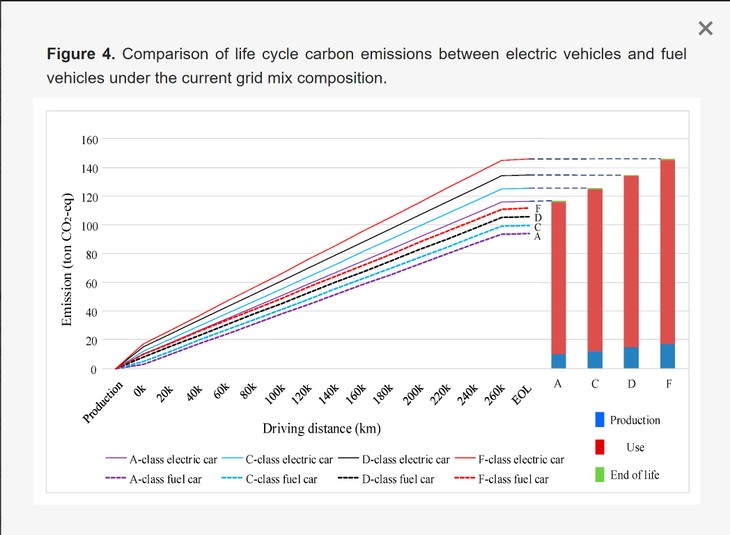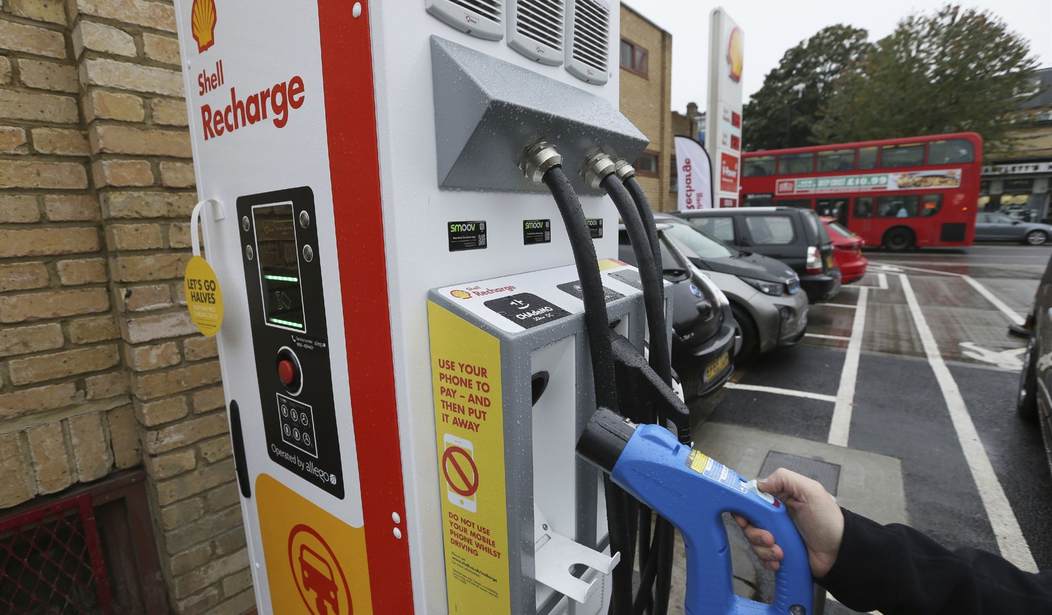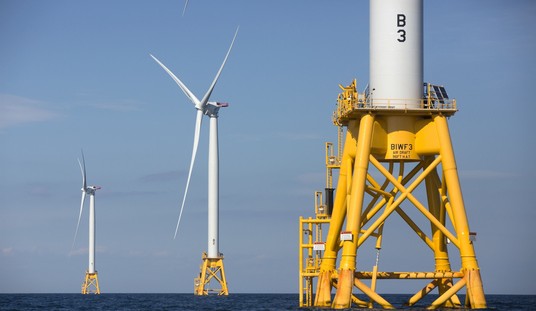If the only reason you’re thinking about buying that snazzy, expensive, battery-operated vehicle to show-off in your driveway is because you believe you’re doing the right thing for the planet, fuggedaboudit.
The clean and green news just keeps getting worse for these electric money pits, no matter how desperate governments are to shove them down an unwilling citizenry’s throat.
Volvo say EVs only become carbon negative from the 9 year mark, which if I'm not corrected is the end of the battery life & who keeps EV for 9 years when the battery is dud, requiring £20k for replacing cells #ClimateScam pic.twitter.com/SaEKFkEspH
— Geordikev (@_Geordi_kev_) July 3, 2023
Even famous British actors are feeling as if they’ve been rolled by the hype without any of the negatives.
Volvo revealed in 2021 that the emission from the production of electric cars can be up to 70 per cent higher than petrol models and said it would require between 30,000 and 68,400 miles for an EV to become greener overall, which typically takes four to nine years.
This is chiefly due to the batteries used to power electric cars. They require raw materials such as cobalt and lithium that need to be mined in places such as Africa and South America before being transported across the globe.
The environmental toll of EV manufacturing led actor Rowan Atkinson to recently claim he felt ‘a little duped’ by electric cars as he urged people to keep hold of their petrol vehicles for longer.
A Chinese electrical college study done in 2019, which attempted to determine the carbon footprint of current EVs within the power grids as they now stand, then projected into 2030 and 2050 (when, in theory, grids have all switched to some sort of renewables vice coal or fossil fuel), found the same exact results. From production, the electric vehicles start out much more carbon intensive than your average internal combustion engine, and remain that way. If this Green scheme of windmills and solar panels blanketing the earth doesn’t pan out in the coming decades, how about them EVs and that carbon emissions problem?
How do you justify mandating them when it’s a verifiable lie from the outset?
1. Through the data collection and analysis of 34 electric models in China, it is found that there is a linear relationship between the whole weight of electric vehicles and the energy consumption of 100 km….[discussion of EV size/battery weights]…The comparison of the carbon emission of electric vehicles and fuel vehicles shows that the full life cycle carbon emission of electric vehicles of any level is higher than that of fuel vehicles of the same level under the current energy structure. In addition, the lifetime carbon emissions of electric vehicles increase with the increase of vehicle weight…
…3. Under the current grid mix composition, the carbon emissions of electric vehicles of the same level are higher than those of fuel vehicles over the whole life cycle….

And, honestly, other than folks who love their Teslas – and God bless them, they are cool, and Elon’s a treasure – who wants to be told what to buy, especially when it’s absolutely nothing that does you any good for some insane kind of money?
People asking that and coming up with the obvious answer is a real problem right now for vehicle manufacturers looking to pump up their volume on EV sales and keep collecting those schweet government subsidies. No matter how many carrots governments shovel at consumers, they aren’t buying what Green dreamers are selling.
…[VW Emden manufacturing plant head] Wulff indicates demand for electric vehicles is up to 30% below originally planned production figures.
“We are experiencing strong customer reluctance in the electric vehicle sector,” he told the North West newspaper.
Thank you, NO. We can do the math.
The left likes to treat skeptics of electrical cars as if they were Luddites. Truth is, making an existing product less efficient but more expensive doesn’t really meet the definition of innovation.
Even the purported amenities and technological advances EV-makers like to brag about in their ads have been a regular feature of gas-powered vehicles going back generations. At best, EVs, if they fulfill their promise, are a lateral technology.
Which is why there is no real “emerging market” for EVs in the United States as much as there’s an industrial policy in place that props up EVs with government purchases, propaganda, endless state subsidies, cronyism, taxpayer-backed loans, and edicts. The green “revolution” is an elite-driven, top-down technocratic project.
…Really, why would a middle-class family shun a perfectly good gas-powered car that can be fueled (most of the time) cheaply and driven virtually any distance, in any environment, and any time of the year? We don’t need lithium. We have the most efficient, affordable, portable, and useful form of energy. We have centuries’ worth of it waiting in the ground.
Drive anywhere, any time, stop and get a bite or continue on, rain, sleet, cold, hot, dark of night, no worries. What a concept.
Dear Twitter, drove my new BYD Atto EV to Canberra. We cannot find a charging station anywhere that is operational and non Tesla. We checked our hotel had them but they failed to tell us for Tesla only. Can anyone help? This is everything you worry about when u buy an EV!
— Jane Caro (@JaneCaro) July 3, 2023
Speaking of lithium, which is a big part of these vehicles being such fraudulent guidon carriers for the environmental movement – at what point do we start noticing and finally get concerned about who controls most of the lithium sources on earth? Considering we’re selling our souls to all things run on lithium, I mean.
…For electric vehicles (EVs), this issue of critical mineral supplies is the key to everything. The main reason why EVs weigh so much more than gas and diesel powered cars is the prodigious amount of critical energy minerals that go into the making of the lithium-ion batteries that power them. The minerals required include lithium, nickel, cobalt, manganese, and graphite, all of which are recovered via hard rock mining operations.
But the U.S. and other countries in North America and Europe made a collective decision to essentially farm out the business of hard rock mining to developing nations and the processing of them to China in the 1980s as part of the environmental priorities of that time. As a result, most supply chains for these and other key energy minerals are under control of the communist Chinese government.
This illustration – which does not include China's recent deal to dominate Bolivia's enormous #Lithium resources – shows why the plans of Western governments to implement this #EnergyTransition from #fossilfuels to #wind, #solar and #EVs will leave their countries almost entirely… https://t.co/DEYgipnt3a
— David Blackmon's Energy Absurdity (@EnergyAbsurdity) July 3, 2023
There are sane heads out there. Brave fellows who are willing to speak up about the insanity of the headlong rush into something untried and that the rest of the infrastructure is in no way, shape or form prepared for.
Like the former CEO/president and new chairman of Toyota.
…Toyoda’s perception of himself as facing off with disparaging elites mirrors how he talks today about the auto world’s transition to electric vehicles. In December, Toyoda said he was standing up for a “silent majority” in the auto industry that questions whether it is right to make EVs the sole option for car buyers.
Many people, he added, hesitate to voice their reservations about EVs because of pressure they feel from pro-EV groups.
Again, the numbers – the #MATHZ – led to Toyota’s decision. They went at it not from their #feelingz but from pencil, paper and calculator.
What’s not to love? And what’s to argue?
…One of his hires was an American chief scientist, Gill Pratt, whose previous jobs included teaching electrical engineering and computer science at the Massachusetts Institute of Technology. Mr. Pratt had researchers run the numbers. He said they showed that factoring in the emissions from manufacturing and generating electricity to charge cars, a diverse lineup of electric and hybrid vehicles has similar lifetime carbon emissions to an EV-only fleet. That was the case even on a power grid getting a significant chunk of its electricity from renewable sources, he said.
Another calculation hinged on the short supplies of lithium for batteries and the fact that hybrid cars, with their smaller batteries, need only a fraction of the lithium used in full EVs.
“Let’s not let perfect be the enemy of good,” Mr. Pratt said at a roundtable in Tokyo on Friday.
Mr. Toyoda gave talks making the case for a diverse lineup of vehicles that would include EVs but not only them. He said that it was hardly environmentally friendly to have coal-fired electricity plants powering cars on the road, and in developing nations of Asia it was unlikely renewables could be built out quickly.
“Ford and GM did a great job convincing Washington that EVs were the only solution,” said Steve Gates, chairman of Toyota’s dealer council. “It’s not popular to talk about things that hybrids and plug-in hybrids have done for the environment.”
I’ll bet Ford and GM did, because they’d be sucking at the government teat. As I posted last week, Ford’s laying off 1000 people in their EV section, but their begging hand is still out.
…In today’s real-world economy, though, Ford announced this week that it was firing at least 1,000 employees — many of them white-collar workers on the EV side. Ford projects it’s going to lose $3 billion on electric vehicles in 2023, bringing its EV losses to $5.1 billion over two years. In 2021, Ford reportedly lost $34,000 on every EV it made. This year it was losing more than $58,000 on every EV. In a normal world, Ford would be dramatically scaling back EV production, not expanding it. Remember that next time we need to bail out Detroit.
Then again, we’re already bailing them out, I suppose. Last week, the U.S. Energy Department lent Ford — again, a company that loses tens of thousands of dollars on every EV it sells — another $9.2 billion in taxpayer dollars for a South Korean battery project. One imagines no sane bank would do it. The cost of EV batteries has gone up, not down, over the past few years.
Afterall, it’s still our money. We are, in effect, buying these thing even though there might not be one in the driveway. Sure would be nice to unplug the cash.
So, give or take 9 years for an EV to be finally be as green as our ’15 Mazda 3, huh? There are so many things to consider if you’re looking at a “used” EV, such as who wants to replace that battery or deal with and older battery to begin with.
EV range will decline
This is where the general battery considerations in going electric become a more specific concern. A EV’s range is likely to degrade over time.Batteries can lose 5% to10% of their power in the first five years and keep degrading after that due to a variety of factors, including age, exposure to temperature extremes, and use of fast charging. If the degradation is excessive, you might need to repair or replace the battery, which can get costly.
Batteries also are one of the most expensive parts of an EV and can cost over $10,000 to replace, but federal rules mandate that they’re covered under warranty for at least eight years or 100,000 miles, so shoppers looking at a lightly used BEV probably still have some coverage left. Plus, even a well-used battery may still have enough capacity to meet your needs.
Will we see EVs as ancient as our Toyota Camry (FTR, Eleanor is a ’96) on the road?
Time will tell, but they will never be as green as she is.








Join the conversation as a VIP Member